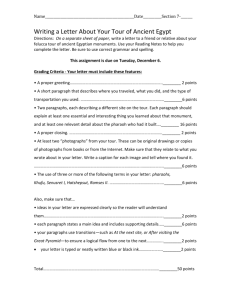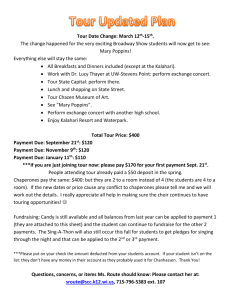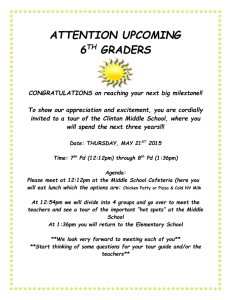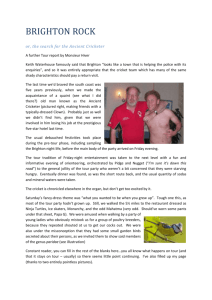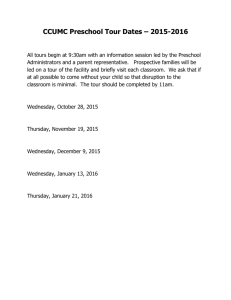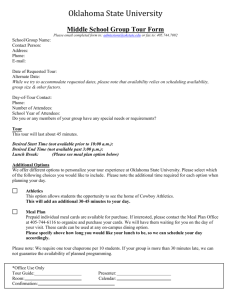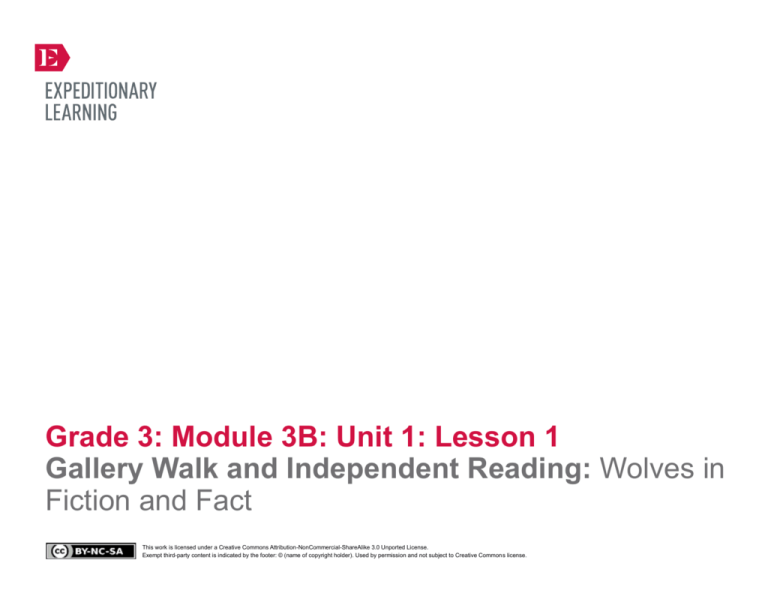
Grade 3: Module 3B: Unit 1: Lesson 1
Gallery Walk and Independent Reading: Wolves in
Fiction and Fact
This work is licensed under a Creative Commons Attribution-NonCommercial-ShareAlike 3.0 Unported License.
Exempt third-party content is indicated by the footer: © (name of copyright holder). Used by permission and not subject to Creative Commons license.
GRADE 3: MODULE 3B: UNIT 1: LESSON 1
Gallery Walk and Independent Reading:
Wolves in Fiction and Fact
Long-Term Targets Addressed (Based on NYSP12 ELA CCLS)
I can ask and answer questions to demonstrate understanding of a text, referring explicitly to the text as the basis for the answers. (RL.3.1)
I can recognize and make connections in narratives, poetry, and drama to other texts, ideas, cultural perspectives, personal events, and situations. (RL.3.11)
I can self-select text based on personal preferences. (RL.3.11a)
I can engage effectively in a range of collaborative discussions with diverse partners, building on others’ ideas and expressing my own clearly. (SL.3.1)
Supporting Learning Targets
Ongoing Assessment
• I can engage in collaborative discussions with peers.
• Tour notes (from Gallery Walk)
• I can ask and answer questions based on what I see and hear during a Gallery Walk.
• Appropriate independent reading selection based on
personal preferences.
• I can select an independent reading text based on personal preferences.
Copyright © 2013 by Expeditionary Learning, New York, NY. All Rights Reserved.
NYS Common Core ELA Curriculum • G3:M3B:U1:L1 • September 2014 • 1
GRADE 3: MODULE 3B: UNIT 1: LESSON 1
Gallery Walk and Independent Reading:
Wolves in Fiction and Fact
Agenda
Teaching Notes
1. Opening
• In this lesson, students participate in a variation of the Gallery Walk protocol. The Gallery Walk in this
unit is introduced as a “mystery,” so it is important not to tell students they will be studying wolves.
Establishing a sense of mystery to kick off the module not only provides engagement but also allows
students to develop and make inferences based on what they see, hear, and feel during the Gallery Walk
experience. If, for some reason, students are already aware of the module topic, conduct the activity as
indicated, but follow up with questions such as: “What does this make you think about wolves?”
A. Engaging the Reader and Introducing Learning
Targets (5 minutes)
2. Work Time
A. Mystery Gallery Walk (30 minutes)
B. Independent Reading Selection (20 minutes)
3. Closing and Assessment
A. Debrief and Reviewing Learning Targets (5 minutes)
4. Homework
A. Read independently for at least 20 minutes; respond
to the independent reading questions.
• In Work Time A, students take a “tour” of the gallery with group members, and make “tour stops” to
record what they see, hear, and feel at each station (see supporting materials for station ideas). If you
were not able to obtain objects for students to touch, you may eliminate this option. Because there are
only three stations, groups will either need to “pair-up” (so there may be eight or more students at each
station), or you may want to create two of each station (six total) so students can spread out. (Other
options include allowing students to choose just two stations to visit instead of all three, or setting up
more than three stations for students to choose from. As you determine the number and types of stops
to set up for the tour, be sure to provide a variety of sensory experiences to address diverse learning
styles.) After the gallery tour, students discuss details from their notes to help them ask questions and
make an inference about what they might learn in the first two units of this module: how wolves are
portrayed in fiction and what wolves are like in real life.
• In Work Time B, students generate ideas about preferences for selecting independent reading texts. This
builds on work from Modules 1 and 2, where students evaluated and developed their “reading
superpowers.” Students’ ideas are recorded onto an anchor chart for reference throughout the module.
• In advance:
– Place students in heterogeneous groups of four, for the duration of this unit. Consider having
stronger readers work with struggling readers to support all students’ ability to access the texts in this
unit. However, use caution when placing students who have large discrepancies in their reading
abilities together, as this may cause embarrassment or frustration. Prepare a list of student groups.
Copyright © 2013 by Expeditionary Learning, New York, NY. All Rights Reserved.
NYS Common Core ELA Curriculum • G3:M3B:U1:L1 • September 2014 • 2
GRADE 3: MODULE 3B: UNIT 1: LESSON 1
Gallery Walk and Independent Reading:
Wolves in Fiction and Fact
Agenda
Teaching Notes (continued)
– Review Gallery Walk protocol (see Appendix).
– Set up three “tour stops” (see supporting materials).
– Determine whether you will use the Conversation Criteria from Module 1, Shared Discussion protocol
from Module 2, or if you will create a new Group Norms anchor chart for students to refer to and use
during group work and discussions throughout this module.
– Create Independent Reading Preferences anchor chart (see example in supporting materials).
– Create Guiding Questions anchor chart to reveal at the end of Work Time A.
• Post: Learning targets; Independent Reading Preferences anchor chart; list of student groups.
Lesson Vocabulary
Materials
engage, collaborative discussions, oral
tradition, lesson, based on, select,
personal preferences
• Tour stop stations (suggestions, for teacher reference; see Teaching Notes)
• Journals (one per student; new notebook with lined-paper; supplied by teacher)
• Tour notes (one per student)
• Glue, tape, or staples (for each student)
• Guiding Questions anchor chart (new; teacher-created)
• Independent Reading Preferences anchor chart (example, for teacher reference)
• Independent reading books (a variety for students to choose from; see Teaching Notes)
• Independent reading questions (one per student)
Copyright © 2013 by Expeditionary Learning, New York, NY. All Rights Reserved.
NYS Common Core ELA Curriculum • G3:M3B:U1:L1 • September 2014 • 3
GRADE 3: MODULE 3B: UNIT 1: LESSON 1
Gallery Walk and Independent Reading:
Wolves in Fiction and Fact
Opening
Meeting Students’ Needs
A. Engaging the Reader and Introducing Learning Targets (5 minutes)
• To support ELLs and visual
learners, locate and display pictorial
representations of key terms from
the targets.
• To support second language
learners, write familiar synonyms
for key terms or students’ restated
versions of targets above each target
• Be sure to have prepared three or more stations in advance, based on the tour stop stations (suggestions, for teacher
reference).
• Bring students together whole group. Tell them that today they are going to become detectives and participate in a Mystery
Gallery Walk to help them make an inference about what they might learn about in this module. Then, they will have an
opportunity to choose a new independent reading book.
• Focus students on the learning targets and ask them to chorally read each one aloud with you:
* “I can engage in collaborative discussions with peers.”
* “I can ask and answer questions based on what I see and hear during a Gallery Walk.”
* “I can select an independent reading text based on personal preferences.”
• Underline the key words and phrases in each target: engage, collaborative discussions, based on, select, and personal
preferences.
• Then, focus students on the first target and ask:
* “Based on previous work with peers, what do you think it means to ‘engage in collaborative discussions’?”
• Invite students to consider the question and then discuss their thinking with a nearby peer.
• After 1 minute, cold call a few students to share out. Answers will vary, but listen for students to make connections to
“conversation criteria” and/or “shared discussions” from previous modules.
• Direct students’ attention to the second target and ask them to consider and discuss with a different nearby peer:
* “How could you restate this target in your own words?”
• After 1 minute, cold call a few student pairs to share their ideas whole class.
• Focus students on the final target and the phrase “personal preferences.” Ask students to briefly discuss with one or the
other of their previous partners:
* “What do you think ‘personal preferences’ means?”
• After 1 minute, invite a few students to share their thinking aloud. Listen for something like: “Personal preferences means
what I want or what I like.” If students are not able to articulate the meaning of “personal preferences,” clarify for them.
• Distribute a new journal to each student, then direct students to join their assigned groups (posted in advance).
Copyright © 2013 by Expeditionary Learning, New York, NY. All Rights Reserved.
NYS Common Core ELA Curriculum • G3:M3B:U1:L1 • September 2014 • 4
GRADE 3: MODULE 3B: UNIT 1: LESSON 1
Gallery Walk and Independent Reading:
Wolves in Fiction and Fact
Work Time
Meeting Students’ Needs
A. Mystery Gallery Walk (30 minutes)
• Explain (or review) Gallery Walk protocol with students. Remind them that this Gallery Walk is a “mystery” because they
will need to use what they see, hear, and feel to help them figure out what they might learn in this module.
• Consider posting the tour directions
for student reference.
• Point out the tour stops and the materials at each station. Explain that groups will rotate around to each of the three tour
stops, where they will read, view, listen, and/or touch a variety of materials that can help them solve the mystery: What will
we be learning about in this module?
• Distribute the tour notes and ask students to glue, tape, or staple it onto first blank page in their journals. Read through
the tour notes with students and answer any clarifying questions.
• For students who struggle with
writing, consider allowing them to
create pictorial representations of
their thinking in the tour notes or
provide a scribe for them to dictate
ideas to.
• Assign groups to stations, then ask them to quickly move to the appropriate area of the room.
• Provide the following directions:
1.
With group members, read the directions at your station. Ask any clarifying questions.
2.
You will have 5 or 6 minutes to follow the directions and fill in the first row of your tour notes.
3.
Prepare to rotate to the next tour stop by returning the materials at your station to their original position(s).
4.
When your teacher gives the signal, move to the next tour stop and repeat the first three steps.
5.
Once you have been to all three stops, review your notes to help you discuss and complete the statement at the bottom of
your tour notes page: “Based on what I saw, heard and touched, I think we will be learning about ___.”
• Clarify directions as needed, then ask students to begin. Circulate to offer support and guidance.
• After 5 or 6 minutes, signal students to finish resetting their stations and move to the second tour stop. Once students are
settled at their new stations, ask them to begin. Continue to circulate and offer guidance.
• After 5 or 6 minutes, signal students to once again finish cleaning up their stations and rotate to the third tour stop. Once
students are ready, ask them to begin.
• After 5 or 6 minutes, ask students to wrap up group discussions and finalize their tour notes, then focus them on the
statement at the bottom of their tour notes once again: “Based on what I saw, heard and touched, I think we will be learning
about ___.”
• Direct students to review their tour notes, think about what they saw, heard, and/or touched at each station, and then
discuss with group members what they think they will be learning about in this module and why.
Copyright © 2013 by Expeditionary Learning, New York, NY. All Rights Reserved.
NYS Common Core ELA Curriculum • G3:M3B:U1:L1 • September 2014 • 5
GRADE 3: MODULE 3B: UNIT 1: LESSON 1
Gallery Walk and Independent Reading:
Wolves in Fiction and Fact
Meeting Students’ Needs
Work Time (continued)
• After 2 or 3 minutes, invite members from multiple groups to share their ideas whole class. Answers will vary depending on
which stations were created, but listen for suggestions like:
– “I think we will learn about stories that have wolves in them, and what wolves are like in stories, because I saw pictures
that looked like they were from story books and the quotes were from stories and had setting, characters, and dialogue”;
– “I think we will be learning about real wolves because there were charts, graphs, photos, and videos of wolves in the wild,
where they live, and what they look like”; etc.
• Confirm or clarify students’ thinking by explaining that in this unit they will get to read stories where wolves are the central
characters. In Unit 2, they will learn about what wolves are like in real life so that in Unit 3, they can use what they have
learned to create their own stories about wolves.
• Then, reveal and read aloud the questions on the Guiding Questions anchor chart:
* “What lessons can be learned from traditional stories?”
* “Who is the wolf in fiction?”
• Explain to students that the traditional stories they will read in this unit all have a wolf as the central character and include
the folktale Lon Po Po, which is a very old (traditional) story from China, as well as a variety of Aesop’s Fables, which were
also written a very long time ago. Tell students that beginning in the next lesson, they will learn more about folktales and
fables and how they were passed from one generation to the next through the use of “oral tradition” (stories shared verbally
rather than read) in order to convey a “lesson” (important message, moral) to the listener.
Copyright © 2013 by Expeditionary Learning, New York, NY. All Rights Reserved.
NYS Common Core ELA Curriculum • G3:M3B:U1:L1 • September 2014 • 6
GRADE 3: MODULE 3B: UNIT 1: LESSON 1
Gallery Walk and Independent Reading:
Wolves in Fiction and Fact
Work Time (continued)
Meeting Students’ Needs
B. Independent Reading Selection (20 minutes)
• Refocus whole group. Direct students’ attention to the posted Independent Reading Preferences anchor chart.
• For struggling readers who may
have trouble selecting appropriate
texts based on multiple preferences,
consider asking them to choose one
preference from the anchor chart to
focus on as they make their
selection.
• If students are not able to choose a
text in the time given, consider
finding time later in the day for text
selection.
• Underline the phrase “personal preferences” and ask a few students to share out what they recall from the Opening about the
meaning of these words. If students have difficulty remembering what “personal preferences” means, clarify for them.
• Within groups, ask students to discuss questions such as:
* “What types of books do you prefer to read?”
* “What types of characters do you prefer?”
* “What types of settings (time and place) do you prefer to read about?”
• After 3 or 4 minutes, cold call members from each group to share their thinking aloud with the class. Record students’ ideas
on the anchor chart.
• Then, show students the independent reading books they have to choose from and ask them to refer to the anchor chart
to help them make an appropriate independent reading selection, based on personal preferences.
• Provide audio versions of texts, as
available.
• Clarify as needed, then ask students to review and choose a book. Circulate to support and offer guidance by posing
questions like:
* “What interests you about this book?”
* “How did you figure out if this book would be interesting to you?”
* “Do you think this book will present any challenges for you? What types of support would help you overcome (a)
challenge(s)?” (e.g., audio or large print version of the text)
• After 10 minutes, invite a few students to share out whole group the book they chose and why they chose it.
Copyright © 2013 by Expeditionary Learning, New York, NY. All Rights Reserved.
NYS Common Core ELA Curriculum • G3:M3B:U1:L1 • September 2014 • 7
GRADE 3: MODULE 3B: UNIT 1: LESSON 1
Gallery Walk and Independent Reading:
Wolves in Fiction and Fact
Closing and Assessment
Meeting Students’ Needs
A. Debrief and Reviewing Learning Targets (5 minutes)
• Focus whole group. Ask students to consider and discuss with a nearby partner:
• For students who struggle to
articulate their thinking aloud,
consider providing a sentence
starter such as, “I think the most
interesting thing about this module
will be________.”
* “Based on what you read, viewed, heard, and/or touched during the Gallery Walk today, what do you think will most
interest you about this module?”
• After 2 minutes, invite a few students to share their thinking whole class.
• Then, redirect students’ attention to the learning targets. Ask students to reread each one aloud with you, pausing between
to show a thumbs-up or thumbs-down to demonstrate their level of mastery toward each target.
• Preview homework. Distribute and read aloud the independent reading questions and answer clarifying questions as
needed.
Homework
Meeting Students’ Needs
• Read your independent reading book for at least 20 minutes.
• Consider providing an audio
recording and/or large print
versions of texts to struggling
readers, as available.
• Complete your independent reading questions.
• Allow struggling writers to dictate
their reading responses to someone
at home to scribe for them.
Copyright © 2013 by Expeditionary Learning, New York, NY. All Rights Reserved.
NYS Common Core ELA Curriculum • G3:M3B:U1:L1 • September 2014 • 8
Grade 3: Module 3B: Unit 1: Lesson 1
Supporting Materials
This work is licensed under a Creative Commons Attribution-NonCommercial-ShareAlike 3.0 Unported License.
Exempt third-party content is indicated by the footer: © (name of copyright holder). Used by permission and not subject to Creative Commons license.
GRADE 3: MODULE 3B: UNIT 1: LESSON 1
Tour Stop Stations
(Suggestions, for Teacher Reference)
Mystery Gallery Walk Teacher Directions:
In different areas of the classroom or another area of the school, create the “Images and Quotes”
station as well as at least two of the other stations described below, for students to stop at during the
Mystery Gallery Walk. Teacher directions are provided to offer guidance regarding how to set up each
station.
Tour Stop: IMAGES and QUOTES
Teacher Directions: Print the following images and quotes from stories onto separate sheets of
paper and/or index cards. Then either set them on a table for students to view and read or hang on
the wall. Be sure to post the tour stop title and student directions.
Student Directions: View and read each of the following images, captions, and quotes. Then,
discuss what you viewed and read with group members and record the tour stop title and your ideas
in a blank row of your tour notes.
Copyright © 2013 by Expeditionary Learning, New York, NY. All Rights Reserved.
NYS Common Core ELA Curriculum • G3:M3B:U1:L1 • September 2014 • 10
GRADE 3: MODULE 3B: UNIT 1: LESSON 1
IMAGES:
THE WOLF AND THE KID
Do not let anything turn you from your purpose.
The Project Gutenberg EBook of The Æsop for Children. "The Wolves and the Kid". Project Gutenberg, 2006. 42. Web. 2014.
Copyright © 2013 by Expeditionary Learning, New York, NY. All Rights Reserved.
NYS Common Core ELA Curriculum • G3:M3B:U1:L1 • September 2014 • 11
GRADE 3: MODULE 3B: UNIT 1: LESSON 1
IMAGES:
THE KID AND THE WOLF
Do not say anything at any time that you would not say at all times.
The Project Gutenberg EBook of The Æsop for Children. "The Kid and the Wolf". Project Gutenberg, 2006. 42. Web. 2014.
Copyright © 2013 by Expeditionary Learning, New York, NY. All Rights Reserved.
NYS Common Core ELA Curriculum • G3:M3B:U1:L1 • September 2014 • 12
GRADE 3: MODULE 3B: UNIT 1: LESSON 1
IMAGES:
THE SHEPHERD BOY AND THE WOLF
Liars are not believed even when they speak the truth.
The Project Gutenberg EBook of The Æsop for Children. "The Shepherd Boy and the Wolf". Project Gutenberg, 2006. 42. Web. 2014.
Copyright © 2013 by Expeditionary Learning, New York, NY. All Rights Reserved.
NYS Common Core ELA Curriculum • G3:M3B:U1:L1 • September 2014 • 13
GRADE 3: MODULE 3B: UNIT 1: LESSON 1
IMAGES:
THE WOLF AND HIS SHADOW
Do not let your fancy make you forget realities.
The Project Gutenberg EBook of The Æsop for Children. "The Wolf and his Shadow". Project Gutenberg, 2006. 42. Web. 2014.
Copyright © 2013 by Expeditionary Learning, New York, NY. All Rights Reserved.
NYS Common Core ELA Curriculum • G3:M3B:U1:L1 • September 2014 • 14
GRADE 3: MODULE 3B: UNIT 1: LESSON 1
QUOTES:
“A crafty wolf, lurking under a sheep’s skin…” (Aesop’s Fables, Jerry Pinkney, book jacket)
“‘Wolf!’ he shouted as loudly as he could. The animal growled and crept closer. ‘Wolf!’ ‘Wolf!’ cried
the frightened boy, but no one came.” (Aesop’s Fables, Jerry Pinkney, p. 11)
“A wolf who lived in the forest fell on hard times, and could barely catch enough food to keep from
starving. Soon her ribs were showing through her coat, and she could hardly sleep at night for
hunger.” (Aesop’s Fables, Jerry Pinkney, p. 48)
“A wolf with a bone caught in his throat darted around the forest begging for help from every
animal he saw. But, wary of his sharp fangs, none dared to come near.” (Aesop’s Fables, Jerry
Pinkney, p. 69)
“As a wolf lay hidden near a shepherd’s home, he smelled a rich, mouthwatering fragrance in the
air.” (Aesop’s Fables, Jerry Pinkney, p. 79)
Copyright © 2013 by Expeditionary Learning, New York, NY. All Rights Reserved.
NYS Common Core ELA Curriculum • G3:M3B:U1:L1 • September 2014 • 15
GRADE 3: MODULE 3B: UNIT 1: LESSON 1
Tour Stop Stations
(Suggestions, for Teacher Reference)
Tour Stop: MUSICAL PERFORMANCE
Teacher Directions: Set up a computer with speakers for students to view and listen to a clip from
the beginning of the Vancouver Symphony Orchestra’s performance of “Peter and the Wolf,” found at
http://www.youtube.com/watch?v=MfM7Y9Pcdzw (0:00 to 1:33). Be sure to post the tour stop title
and student directions.
Student Directions: With group members, view and listen to the clip of the Vancouver Symphony
Orchestra’s performance of “Peter and the Wolf,” from the beginning to 1:33. Once you reach 1:33 of
the video, pause, rewind to the beginning, and watch at least one more time, stopping at 1:33 a second
time. After viewing and listening to the clip at least twice, discuss what you hear, see, and wonder with
your group members. Record the tour stop title and your thinking about what you heard and saw in a
new row of your tour notes.
Copyright © 2013 by Expeditionary Learning, New York, NY. All Rights Reserved.
NYS Common Core ELA Curriculum • G3:M3B:U1:L1 • September 2014 • 16
GRADE 3: MODULE 3B: UNIT 1: LESSON 1
Tour Stop Stations
(Suggestions, for Teacher Reference)
Tour Stop: FACTS and DATA
Teacher Directions: Print the following data and record the facts onto separate index cards or
sheets of paper. Then either set them on a table for students to view and read or hang them on the
wall. Be sure to post the tour stop title and student directions.
Student Directions: View and read each of the following graphs, charts, and facts. Then discuss
what you view and read with group members. After your group discussion, be sure to record the tour
stop title and your thinking about what you viewed and read in a new row of your tour notes.
Copyright © 2013 by Expeditionary Learning, New York, NY. All Rights Reserved.
NYS Common Core ELA Curriculum • G3:M3B:U1:L1 • September 2014 • 17
GRADE 3: MODULE 3B: UNIT 1: LESSON 1
Tour Stop Stations
(Suggestions, for Teacher Reference)
Map of wolf attacks on humans in France (from 1400 to 1918)
1 to 9 cases
10 to 19 cases
20 to 49 cases
50 to 99 cases
More than 100 cases
No data
DewClouds. Public Domain
Copyright © 2013 by Expeditionary Learning, New York, NY. All Rights Reserved.
NYS Common Core ELA Curriculum • G3:M3B:U1:L1 • September 2014 • 18
GRADE 3: MODULE 3B: UNIT 1: LESSON 1
Tour Stop Stations
(Suggestions, for Teacher Reference)
Map of gray wolf packs in Oregon as of December 31, 2012
There are at least 53 individual wolves in the state.
Oregon Department of Fish and Wildlife. Public Domain
Copyright © 2013 by Expeditionary Learning, New York, NY. All Rights Reserved.
NYS Common Core ELA Curriculum • G3:M3B:U1:L1 • September 2014 • 19
GRADE 3: MODULE 3B: UNIT 1: LESSON 1
Tour Stop Stations
(Suggestions, for Teacher Reference)
The larger skull is from a wild grey wolf. The smaller is from a Chihuahua. They are, in fact,
considered the same species.
Dmccabe
http://creativecommons.org/licenses/by-sa/3.0/deed.en
Copyright © 2013 by Expeditionary Learning, New York, NY. All Rights Reserved.
NYS Common Core ELA Curriculum • G3:M3B:U1:L1 • September 2014 • 20
GRADE 3: MODULE 3B: UNIT 1: LESSON 1
Tour Stop Stations
(Suggestions, for Teacher Reference)
The Gibbon wolf pack pauses in the snowy landscape.
Photo by Doug Smith National Park Service
Copyright © 2013 by Expeditionary Learning, New York, NY. All Rights Reserved.
NYS Common Core ELA Curriculum • G3:M3B:U1:L1 • September 2014 • 21
GRADE 3: MODULE 3B: UNIT 1: LESSON 1
Tour Stop Stations
(Suggestions, for Teacher Reference)
Wolves (Canis lupus) at Polar Zoo in the municipality of Bardu, Troms County, Norway.
Taral Jansen http://creativecommons.org/licenses/by/2.0/deed.en
Copyright © 2013 by Expeditionary Learning, New York, NY. All Rights Reserved.
NYS Common Core ELA Curriculum • G3:M3B:U1:L1 • September 2014 • 22
GRADE 3: MODULE 3B: UNIT 1: LESSON 1
Tour Stop Stations
(Suggestions, for Teacher Reference)
Wolf Range Map
Fast Facts
Type: Mammal
Diet: Carnivore
Average life span in the wild: 6–8 years
Size: Head and body, 36–63 inches (91–60 cm); Tail, 13–20 inches (33–51 cm)
Weight: 40–175 lbs. (18–79 kg)
Group name: Pack
Protection status: Endangered
Size relative to a 6-ft (2-m) man:
Copyright © National Geographic. Used by permission and not subject to Creative Commons license.
Copyright © National Geographic. Used by permission and not subject to Creative
Commons license.
NYS Common Core ELA Curriculum • G3:M3B:U1:L1 • September 2014 • 23
GRADE 3: MODULE 3B: UNIT 1: LESSON 1
Tour Stop Stations
(Suggestions, for Teacher Reference)
Gray wolves once populated large portions of North America, Europe, and Asia, but were hunted to
near extinction. Their numbers have rebounded due to conservation and reintroduction efforts.
photo by hehaden http://creativecommons.org/licenses/by-nc/2.0/
Copyright © 2013 by Expeditionary Learning, New York, NY. All Rights Reserved.
NYS Common Core ELA Curriculum • G3:M3B:U1:L1 • September 2014 • 24
GRADE 3: MODULE 3B: UNIT 1: LESSON 1
Tour Stop Stations
(Suggestions, for Teacher Reference)
Tour Stop: VIDEO CLIP “In the Valley of the Wolves”
Teacher Directions: Set up a computer with speakers for students to view and listen to a clip from
the video “In the Valley of the Wolves,” found at http://www.pbs.org/wnet/nature/episodes/in-thevalley-of-the-wolves/video-full-episode/4678/ (0:00 to 1:47). Be sure to post the tour stop title and
student directions.
Student Directions: With group members, view and listen to the video clip from “In the Valley of
the Wolves,” from the beginning to 1:47. Once you reach 1:47, pause, rewind to the beginning, and
watch at least one more time, stopping at 1:47 a second time. After viewing and listening to the clip at
least twice, discuss what you hear, see, and wonder with your group members. Record the tour title
and your thinking about what you heard and saw in a new row of your tour notes.
Video used with permission.
Copyright © 2013 by Expeditionary Learning, New York, NY. All Rights Reserved.
NYS Common Core ELA Curriculum • G3:M3B:U1:L1 • September 2014 • 25
GRADE 3: MODULE 3B: UNIT 1: LESSON 1
Tour Stop Stations
(Suggestions, for Teacher Reference)
Tour Stop: WOLF SOUNDS AUDIO
Teacher Directions: Set up a computer with speakers for students to listen to various audio
recordings of “Wolf Sounds” from Wolfpark.org, found at http://wolfpark.org/animals/sounds/
(“Chorus Howl” 1–5 and “Fussing Puppies”). Be sure to post the tour stop title and student directions.
Student Directions: With group members, listen to the audio clips of wolves howling and new wolf
pups (six audio clips total). After listening to each clip at least once, discuss what you hear and
wonder about the sounds you heard with your group members. Record the tour title and your
thinking about what you heard in a new row of your tour notes.
Copyright © 2013 by Expeditionary Learning, New York, NY. All Rights Reserved.
NYS Common Core ELA Curriculum • G3:M3B:U1:L1 • September 2014 • 26
GRADE 3: MODULE 3B: UNIT 1: LESSON 1
Tour Stop Stations
(Suggestions, for Teacher Reference)
Tour Stop: WEBCAM VIDEOS OF WOLVES
Teacher Directions: Set up a computer with speakers for students to view and listen to the webcam
feeds found on the Endangered Wolf Center website, found at
http://www.endangeredwolfcenter.org/webcams/ (Mexican Gray Wolf Pack camera; Painted Dog
Den cameras 1 and 2; Painted Dog Enclosure camera). Be sure to post the tour stop title and student
directions.
Student Directions: With group members, view and listen to the four webcam videos from the
Endangered Wolf Center website (Mexican Gray Wolf Pack camera; Painted Dog Den cameras 1 and 2;
Painted Dog Enclosure camera). After viewing and listening to each webcam video at least once,
discuss what you hear, see, and wonder with your group members. Record the tour title and your
thinking about what you heard and saw in a new row of your tour notes.
Copyright © 2013 by Expeditionary Learning, New York, NY. All Rights Reserved.
NYS Common Core ELA Curriculum • G3:M3B:U1:L1 • September 2014 • 27
GRADE 3: MODULE 3B: UNIT 1: LESSON 1
Tour Stop Stations
(Suggestions, for Teacher Reference)
Tour Stop: ARTIFACTS
Teacher Directions: Collect and display a variety of artifacts related to wolves that students can
physically touch (see note in Unit Overview, Preparation and Materials). Place the artifacts on a table
for students to touch and view. Be sure to post the tour stop title and student directions.
Student Directions: Look at and touch (pick up, hold, etc.) each of the artifacts. Then discuss what
you see and touch with group members. After your group discussion, be sure to record the tour stop
title and your thinking about what saw and touched in a new row of your tour notes.
Copyright © 2013 by Expeditionary Learning, New York, NY. All Rights Reserved.
NYS Common Core ELA Curriculum • G3:M3B:U1:L1 • September 2014 • 28
GRADE 3: MODULE 3B: UNIT 1: LESSON 1
Tour Notes
Name:
Date:
Follow the directions at each tour stop and take notes below about what you see, hear, touch, and
wonder, to help you solve the “mystery” of what we will be studying in this module.
Tour Stop
(title)
What I see
Copyright © 2013 by Expeditionary Learning, New York, NY. All Rights Reserved.
What I hear
What I feel/touch
(optional)
What I wonder
NYS Common Core ELA Curriculum • G3:M3B:U1:L1 • September 2014 • 29
GRADE 3: MODULE 3B: UNIT 1: LESSON 1
Tour Notes
Based on what I saw, heard, and touched, I think we will be learning about
.
Copyright © 2013 by Expeditionary Learning, New York, NY. All Rights Reserved.
NYS Common Core ELA Curriculum • G3:M3B:U1:L1 • September 2014 • 30
GRADE 3: MODULE 3B: UNIT 1: LESSON 1
Guiding Questions Anchor Chart
(Example, for Teacher Reference)
What lessons can be learned from traditional stories?
Who is the wolf in fiction?
Copyright © 2013 by Expeditionary Learning, New York, NY. All Rights Reserved.
NYS Common Core ELA Curriculum • G3:M3B:U1:L1 • September 2014 • 31
GRADE 3: MODULE 3B: UNIT 1: LESSON 1
Independent Reading Preferences Anchor Chart
(Example, for Teacher Reference)
The italicized text in the chart indicates examples of ideas students might share. If students do not
mention them during the whole group brainstorm at the beginning of Work Time B, consider adding
them and/or other ideas you think are important to highlight for students.
Independent Reading Preferences
Characters in the story are interesting, funny, wild, kind, intelligent, athletic (etc.); easy to relate to,
understand; similar to me (personality, looks, etc.); have interests, hobbies that are similar to my
own.
Setting: Story takes place in the past, present, future; a setting that is familiar, completely
unfamiliar, made-up, real; a real place I have visited and enjoyed; a place I have always wanted to
visit (etc.)
mystery;
adventure;
factual information mixed with made-up characters and/or settings;
all make-believe characters;
magic;
chapters/no chapters;
audio version available;
many images/very few or no pictures;
Copyright © 2013 by Expeditionary Learning, New York, NY. All Rights Reserved.
NYS Common Core ELA Curriculum • G3:M3B:U1:L1 • September 2014 • 32
GRADE 3: MODULE 3B: UNIT 1: LESSON 1
Independent Reading Questions
After reading independently for at least 20 minutes, write responses to the questions below based on
what you have read so far.
1. What do you like most about your independent reading book so far? Why?
2. Based on what you have read so far, do you think you would recommend this book to a friend?
Why or why not?
Copyright © 2013 by Expeditionary Learning, New York, NY. All Rights Reserved.
NYS Common Core ELA Curriculum • G3:M3B:U1:L1 • September 2014 • 33





